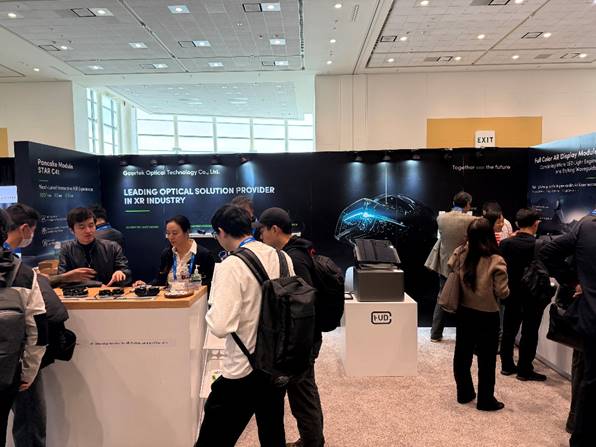Recently, the internationally renowned XR event SPIE AR|VR|MR concluded in San Francisco, USA. SPIE AR|VR|MR, organized by SPIE (The International Society for Optics and Photonics), is a well-known gathering in the XR industry, now in its tenth consecutive year. The event focuses on the upstream of VR/AR hardware, including digital optics, near-eye displays, materials, display technology, and light engines, attracting a large number of researchers, upstream enterprises, potential customers, and investors annually.
This year, 78 exhibitors from around the world participated in the event, creating a more vibrant atmosphere than in previous years. Among the international exhibitors were well-known AR companies and institutions such as Dispelix, Schott, Google, and Meta Reality Labs. Domestically, companies like Goertek Optics also attended and showcased cutting-edge XR optical solutions to a global audience.Goertek Optics, making its debut at SPIE AR|VR|MR, showcased a range of optical solutions covering VR, AR, and smart cockpits. The booth was bustling with visitors, who were impressed by the innovative solutions and excellent demonstration effects, leading to numerous inquiries and discussions about potential collaborations. Notably, Goertek Optics unveiled the Star G-E1, a full-color waveguide display module, for the first time at the event. This module features a surface relief grating (SRG) waveguide, with its manufacturing process upgraded from nanoimprint to a cutting-edge etching solution, significantly enhancing the optical performance metrics compared to previous models.
Visitors experienced the etched waveguide display module Star G-E1, which was demonstrated with a Micro-LED full-color light engine (based on X-cube color synthesis). In terms of key indicators, the screen resolution is 640×480, the product achieves a peak brightness of 5000 nits, with brightness uniformity exceeding 45% and color difference less than 0.02. The waveguide is a single-piece full-color, with a thickness of only 0.7mm. Attendees reported that the Star G-E1 module has vibrant colors and excellent brightness performance, meeting the needs for all-weather use. Additionally, the screen demonstrated outstanding control over stray light, leading in the industry. Focusing on etched relief grating waveguides, Goertek Optics possesses full-chain technology development and mass production capabilities. Besides the modules showcased at the event, future releases will include versions compatible with larger fields of view.In addition to the Star G-E1, Goertek Optics showcased a variety of products including a dual-focus single-engine diffractive waveguide AR display module, multiple 4K Pancake VR optical modules, and AR-HUDs. The single-engine diffractive waveguide AR display module, which was also displayed during CES, comes in both monochrome and full-color versions. The monochrome version is paired with a Micro-LED engine, while the full-color version is paired with Goertek Optics’ self-developed 0.7cc ultra-compact LCoS engine. The advantage of the single-engine dual-eye design is its effective cost reduction and excellent display consistency.
At the beginning of January’s CES exhibition, AI glasses undoubtedly became one of the most sought-after categories. Similarly, at the SPIE AR|VR|MR event, ‘AI glasses’ were a significant topic among the guests. Whether in keynote speeches or interviews, many discussions on related topics were heard. The reason for the attention AI glasses receive is partly due to the star effect of the hit product Ray-Ban Meta and partly because glasses, among various hardware forms, are relatively close to our auditory and visual centers, making them more likely to become the ideal AI hardware of the future. Data indicates that global AI glasses sales exceeded 2 million units in 2024, and some manufacturers predict that AI glasses shipments will reach tens of millions by 2026. Of course, there is still much room for improvement in the AI glasses experience. It is understood that in 2025, major manufacturers will optimize their products around the following aspects: further refining the AI experience, improving photography capabilities, and adopting a multi-SKU strategy to meet consumer personalized needs. Additionally, AI glasses products are still primarily auditory, and it is expected that many products will complete the display module in the new year, evolving towards AI+AR glasses. At that time, optical display is expected to become one of the important selling points for such products. It is also worth noting that optics is one of the most valuable technologies in AR glasses products, with the BOM cost of optical display modules often accounting for more than 40%. In the optical part, this is where manufacturers like Goertek Optics will shine in the future AI glasses race. Goertek Optics may be one of the most active manufacturers in the domestic AI+XR track, having developed for 12 years and being the first in the industry to launch a 4K Pancake folding optical path module in the VR track; in the AR track, it was the first to establish a 12-inch wafer AR diffractive waveguide product production line.Gorilla Optics has not only established a comprehensive capability in optical solution design, optomechanical development, optical testing, manufacturing, and automated assembly of modules, but also has formed a strong technical barrier and market competitiveness. As of September 2024, the company has accumulated over 3000 patents.
For consumers, we can also anticipate that with the deployment of modules like Star G-E1, the market will soon see AI+AR glasses products that are lighter, more immersive in picture effects, and offer a superior overall experience.


